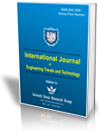Kernel Piecewise Regressive Gradient Multilayer Perceptron Learning for Early Detection of Breast Cancer Using Mammographic Images
Kernel Piecewise Regressive Gradient Multilayer Perceptron Learning for Early Detection of Breast Cancer Using Mammographic Images |
||
 |
 |
|
| © 2025 by IJETT Journal | ||
| Volume-73 Issue-10 |
||
| Year of Publication : 2025 | ||
| Author : Razul Beevi.I, Balaji.T | ||
| DOI : 10.14445/22315381/IJETT-V73I10P109 | ||
How to Cite?
Razul Beevi.I, Balaji.T,"Kernel Piecewise Regressive Gradient Multilayer Perceptron Learning for Early Detection of Breast Cancer Using Mammographic Images", International Journal of Engineering Trends and Technology, vol. 73, no. 10, pp.117-131, 2025. Crossref, https://doi.org/10.14445/22315381/IJETT-V73I10P109
Abstract
Breast cancer is considered one of the most life-threatening forms of cancer among women worldwide. Early detection plays a pivotal role in helping doctors diagnose benign from malignant breast cancers for successful treatment and improved outcomes. Conventionally, breast cancer detection using machine learning and deep learning techniques has been developed for early diagnosis and treatment. However, achieving accurate detection with minimal time consumption poses significant challenges. A novel technique named Kernel Piecewise Regressive Gradient Multilayer Perceptron Learning (KPRGMPL) has been developed to address this Issue. It consists of three processes: preprocessing, feature extraction, and classification. The input layer receives numerous mammogram images. These images are processed through hidden layers. Image preprocessing in the first hidden layer is performed using Dixon’s statistical Savitzky-Golay filtering technique by reducing noise artifacts. Radial kernel proximity lambda-connectedness image segmentation is performed in the second hidden layer to segment the image into multiple regions and extract the Region of Interest (ROI). Subsequently, features such as texture and size are extracted from the ROI for accurate cancer detection with minimal time. Finally, classification is carried out in the third hidden layer to detect breast cancer at an earlier stage by employing the Hamann indexive Piecewise Linear Regression(PLR). To minimize the error, a stochastic gradient function is applied. The accurately classified results are then obtained at the output layer. Experiments are evaluated with different evaluation metrics. The observed result shows the effectiveness of the proposed KPRGMPL technique, which has higher accuracy and minimum time than the existing methods.
Keywords
Breast Cancer Detection, Mammographic Images, Kernel Piecewise Regressive Gradient Multilayer Perceptron Learning, Dixon’s Statistical Savitzky-Golay Filtering Technique, Radial Kernel Proximity Lambda-Connectedness Image Segmentation, Hamann Indexive Piecewise Linear Regression.
References
[1] Muhammet Fatih Aslan, “A Hybrid End-To-End Learning Approach for Breast Cancer Diagnosis: Convolutional Recurrent Network,” Computers and Electrical Engineering, vol. 105, pp. 1-15, 2023.
[CrossRef] [Google Scholar] [Publisher Link]
[2] Jawad Ahmad et al., “Breast Cancer Detection using Deep Learning: An Investigation using the DDSM Dataset and a Customized AlexNet and Support Vector Machine,” IEEE Access, vol. 11, pp. 108386-108397, 2023.
[CrossRef] [Google Scholar] [Publisher Link]
[3] Raj Kumar Pattnaik et al., “Breast Cancer Detection and Classification using Metaheuristic Optimized Ensemble Extreme Learning Machine,” International Journal of Information Technology, vol. 15, no. 8, pp. 4551-4563, 2023.
[CrossRef] [Google Scholar] [Publisher Link]
[4] Hanan Aljuaid et al., “Computer-Aided Diagnosis for Breast Cancer Classification using Deep Neural Networks and Transfer Learning,” Computer Methods and Programs in Biomedicine, vol. 223, pp. 1-10, 2022.
[CrossRef] [Google Scholar] [Publisher Link]
[5] Adyasha Sahu, Pradeep Kumar Das, and Sukadev Meher, “Recent Advancements in Machine Learning and Deep Learning-Based Breast Cancer Detection using Mammograms,” Physica Medica, vol. 114, pp. 1-16, 2023.
[CrossRef] [Google Scholar] [Publisher Link]
[6] Subasish Mohapatra et al., “Evaluation of Deep Learning Models for Detecting Breast Cancer using Histopathological Mammograms Images,” Sustainable Operations and Computers, vol. 3, pp. 296-302, 2022.
[CrossRef] [Google Scholar] [Publisher Link]
[7] Bunyodbek Ibrokhimov, and Justin-Youngwook Kang, “Two-Stage Deep Learning Method for Breast Cancer Detection Using High-Resolution Mammogram Images,” Applied Sciences, vol. 12, no. 9, pp. 1-14, 2022.
[CrossRef] [Google Scholar] [Publisher Link]
[8] Ayman Altameem et al., “Breast Cancer Detection in Mammography Images using Deep Convolutional Neural Networks and Fuzzy Ensemble Modeling Techniques,” Diagnostics, vol. 12, no. 8, pp. 1-16, 2022.
[CrossRef] [Google Scholar] [Publisher Link]
[9] Sarmad Maqsood, Robertas Damaševiˇcius, and Rytis Maskeliunas, “TTCNN: A Breast Cancer Detection and Classification Towards Computer-Aided Diagnosis using Digital Mammography in Early Stages,” Applied Sciences, vol. 12, no. 7, pp. 1-27, 2022.
[CrossRef] [Google Scholar] [Publisher Link]
[10] Farnoosh Azour, and Azzedine Boukerche, “Design Guidelines for Mammogram-Based Computer-Aided Systems using Deep Learning Techniques,” IEEE Access, vol. 10, pp. 21701-21726.
[CrossRef] [Google Scholar] [Publisher Link]
[11] Muhammad Anas et al., “Advancing Breast Cancer Detection: Enhancing YOLOv5 Network for Accurate Classification in Mammogram Images,” IEEE Access, vol. 12, pp. 16474-16488, 2024.
[CrossRef] [Google Scholar] [Publisher Link]
[12] Bita Asadi, and Qurban Memon, “Efficient Breast Cancer Detection via Cascade Deep Learning Network,” International Journal of Intelligent Networks, vol. 4, pp. 46-52, 2023.
[CrossRef] [Google Scholar] [Publisher Link]
[13] Mohsen Ghorbian, and Saeid Ghorbian, “Usefulness of Machine Learning and Deep Learning Approaches in Screening and Early Detection of Breast Cancer,” Heliyon, vol. 9, no. 12, pp. 1-34, 2023.
[CrossRef] [Google Scholar] [Publisher Link]
[14] Kosmia Loizidou et al., “Automatic Breast Mass Segmentation and Classification using Subtraction of Temporally Sequential Digital Mammograms,” IEEE Journal of Translational Engineering in Health and Medicine, vol. 10, pp. 1-11, 2022.
[CrossRef] [Google Scholar] [Publisher Link]
[15] Hao Du et al., “Automatic Calcification Morphology and Distribution Classification for Breast Mammograms with Multi-Task Graph Convolutional Neural Network,” IEEE Journal of Biomedical and Health Informatics, vol. 27, no. 8, pp. 3782-3793, 2023.
[CrossRef] [Google Scholar] [Publisher Link]
[16] Farnoosh Azour, and Azzedine Boukerche, “An Efficient Transfer and Ensemble Learning based Computer Aided Breast Abnormality Diagnosis System,” IEEE Access, vol. 11, pp. 21199-21209, 2023.
[CrossRef] [Google Scholar] [Publisher Link]
[17] L. Lakshmi et al., “WOMT: Wasserstein Distribution based Minimization of False Positives in Breast Tumor Classification using Deep Learning,” IEEE Access, vol. 11, pp. 57831-57842, 2023.
[CrossRef] [Google Scholar] [Publisher Link]
[18] Zahra Jafari, and Ebrahim Karami, “Breast Cancer Detection in Mammography Images: A CNN-Based Approach with Feature Selection,” Information, vol. 14, no. 7, pp. 1-14, 2023.
[CrossRef] [Google Scholar] [Publisher Link]
[19] Kiran Jabeen et al., “BC2NetRF: Breast Cancer Classification from Mammogram Images using Enhanced Deep Learning Features and Equilibrium-Jaya Controlled Regula Falsi-Based Features Selection,” Diagnostics, vol. 13, no. 7, pp. 1-22, 2023.
[CrossRef] [Google Scholar] [Publisher Link]
[20] Abdelali Elmoufidi, “Deep Multiple Instance Learning for Automatic Breast Cancer Assessment using Digital Mammography,” IEEE Transactions on Instrumentation and Measurement, vol. 71, pp. 1-13, 2022.
[CrossRef] [Google Scholar] [Publisher Link]
[21] Daiju Ueda et al., “Development and Validation of a Deep Learning Model for Detection of Breast Cancers in Mammography from Multi-Institutional Datasets,” PLoS One, vol. 17, no. 3, pp. 1-15, 2022.
[CrossRef] [Google Scholar] [Publisher Link]
[22] Indrajeet Kumar et al., “Dense Tissue Pattern Characterization using Deep Neural Network,” Cognitive Computation, vol. 14, no. 5, pp. 1728-1751, 2022.
[CrossRef] [Google Scholar] [Publisher Link]
[23] Debendra Muduli, Ratnakar Dash, and Banshidhar Majhi, “Automated Diagnosis of Breast Cancer using Multi-Modal Datasets: A Deep Convolution Neural Network based Approach,” Biomedical Signal Processing and Control, vol. 71, 2022.
[CrossRef] [Google Scholar] [Publisher Link]
[24] Imran Ul Haq et al., “Feature Fusion and Ensemble Learning-Based CNN Model for Mammographic Image Classification,” Journal of King Saud University - Computer and Information Sciences, vol. 34, no. 6, pp. 3310-3318, 2022.
[CrossRef] [Google Scholar] [Publisher Link]
[25] Umar Albalawi, S Manimurugan, and R Varatharajan, “Classification of Breast Cancer Mammogram Images using Convolution Neural Network,” Concurrency and Computation Practice and Experience, vol. 34, no. 13, 2022.
[CrossRef] [Google Scholar] [Publisher Link]
[26] Clara Cruz-Ramos et al., “Benign and Malignant Breast Tumor Classification in Ultrasound and Mammography Images via Fusion of Deep Learning and Handcraft Features,” Entropy, vol. 25, no. 7, pp. 1-32, 2023.
[CrossRef] [Google Scholar] [Publisher Link]
[27] Ramiro Isa-Jara et al., “GEMA-An Automatic Segmentation Method for Real-Time Analysis of Mammalian Cell Growth in Microfluidic Devices,” Journal of Imaging, vol. 8, no. 10, pp. 1-18, 2022.
[CrossRef] [Google Scholar] [Publisher Link]
[28] Mohammad Reza Abbasniya et al., “Classification of Breast Tumours based on Histopathology Images Using Deep Features and Ensemble of Gradient Boosting Methods,” Computers and Electrical Engineering, vol. 103, pp. 1-14, 2022.
[CrossRef] [Google Scholar] [Publisher Link]
[29] Mahati Munikoti Srikantamurthy et al., “Classification of Benign and Malignant Subtypes of Breast Cancer Histopathology Imaging using Hybrid CNN-LSTM based Transfer Learning,” BMC Medical Imaging, vol. 23, no. 1, pp. 1-15, 2023.
[CrossRef] [Google Scholar] [Publisher Link]
[30] Mehedi Masud, Amr E. Eldin Rashed, and M. Shamim Hossain, “Convolutional Neural Network-Based Models for Diagnosis of Breast Cancer,” Neural Computing and Applications, vol. 34, no. 14, pp. 11383-11394, 2020.
[CrossRef] [Google Scholar] [Publisher Link]
[31] Md. Atiqur Rahman et al., “Enhancing Early Breast Cancer Detection Through Advanced Data Analysis,” IEEE Access, vol. 12, pp. 161941-161953, 2024.
[CrossRef] [Google Scholar] [Publisher Link]
[32] Idan Kassis et al., “Detection of Breast Cancer in Digital Breast Tomosynthesis with Vision Transformers,” Scientific Reports, vol. 14, no. 1, pp. 1-12, 2024.
[CrossRef] [Google Scholar] [Publisher Link]
[33] Hussain Alsalman et al., “Federated Learning Approach for Breast Cancer Detection based on DCNN,” IEEE Access, vol. 12, pp. 40114-40138, 2024.
[CrossRef] [Google Scholar] [Publisher Link]
[34] Ahad Alloqmani, Yoosef B. Abushark, and Asif Irshad Khans, “Anomaly Detection of Breast Cancer using Deep Learning,” Arabian Journal for Science and Engineering, vol. 48, no. 8, pp. 10977-11002, 2023.
[CrossRef] [Google Scholar] [Publisher Link]
[35] Bitao Jiang et al., “Deep Learning Applications in Breast Cancer Histopathological Imaging: Diagnosis, Treatment, and Prognosis,” Breast Cancer Research, vol. 26, no. 1, pp. 1-17, 2024.
[CrossRef] [Google Scholar] [Publisher Link]

